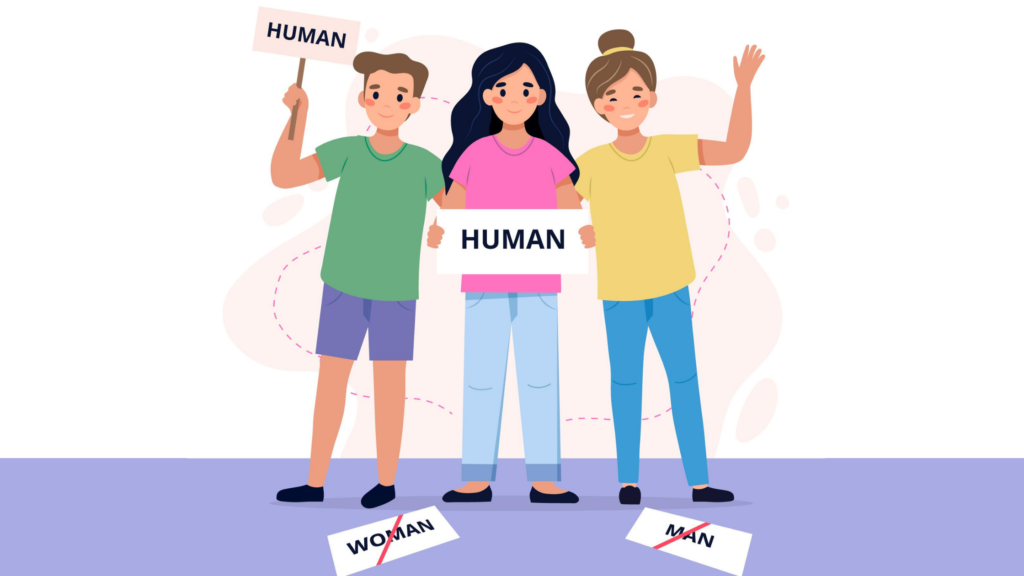Language is a powerful tool that shapes our perception of the world and reflects our attitudes towards others. In recent years, there has been a growing recognition of the importance of using gender-neutral language to promote inclusivity and challenge traditional gender stereotypes. The recent revision of the definitions of “man” and “woman” by the Cambridge Dictionary is a significant step towards embracing the diversity of gender identities. However, the journey towards linguistic inclusivity requires the concerted efforts of educators, policymakers, journalists, and students.
Challenging Gender Stereotypes
Gendered language refers to words, phrases, and expressions that reflect or reinforce traditional gender roles and stereotypes. It includes the use of specific nouns, pronouns, titles, and other linguistic conventions that associate gender with certain roles, professions, or social positions. It is important to be aware of gendered language because it can perpetuate inequality, reinforce biases, and exclude or marginalize individuals based on their gender identity.
Using gendered language can have several negative effects. First, it can contribute to the erasure or invisibility of individuals who do not conform to traditional gender norms. By using language that assumes everyone is male or female, people who identify as non-binary, genderqueer, or gender non-conforming may feel excluded or invalidated. Gendered language also reinforces stereotypes by associating certain qualities, roles, or professions with a specific gender, limiting opportunities and reinforcing gender inequalities. For example, using terms like “policeman” or “fireman” suggests that these professions are inherently masculine, disregarding the contributions of women in these fields.
Furthermore, gendered language can hinder effective communication and understanding. As language evolves and society becomes more inclusive, using gender-neutral language has become standard practice in many contexts. Employing gender-neutral language promotes inclusivity, respects diverse gender identities, and ensures that communication is clear and accessible to all individuals.

Addressing gendered language in writing requires careful consideration and awareness. While there may not be universally agreed-upon guidelines, there are strategies that can be employed. One approach is to replace gendered nouns, such as “man” or words ending in “-man,” with more neutral alternatives. For instance, using “person” or “individual” instead of “man” creates more inclusive language. Similarly, modifying job titles to remove gender-specific assumptions can help challenge stereotypes and promote equality.
Traditional concepts of gender have often been limited to a binary understanding of male and female. This exclusionary approach fails to recognize the lived experiences of individuals who identify as non-binary, genderqueer, agender, or gender-non-conforming. By expanding the definitions of “man” and “woman” to include individuals who may have had a different sex assigned at birth but identify with a particular gender, the Cambridge Dictionary acknowledges the importance of respecting individuals’ self-identified gender.
Gender pronouns are a significant aspect of the broader discussion on gender-neutral language and inclusivity. In recent years, there has been a growing recognition of the importance of using gender-neutral pronouns to create a more inclusive and respectful society.
Traditionally, English pronouns such as “he” and “she” have been used to refer to individuals based on their perceived gender. However, as our understanding of gender identity has evolved, it has become apparent that not everyone identifies strictly as male or female. Many individuals identify as non-binary, genderqueer, or gender non-conforming, and using binary pronouns may exclude or invalidate their identities.
To address this, gender-neutral pronouns have emerged as inclusive alternatives. One commonly used gender-neutral pronoun is “they/them/their” when referring to a singular person. While some may argue that using “they” as a singular pronoun is grammatically incorrect, it has been used in English for centuries and has historical precedent. It is important to remember that language is dynamic and evolves over time to meet the needs of society.
The use of gender-neutral pronouns acknowledges and respects the diverse gender identities of individuals. It allows everyone, regardless of their gender identity, to be seen and recognized in language. Using the correct pronouns is an essential aspect of affirming someone’s identity and promoting inclusivity.
However, it is crucial to note that not all individuals may use the same pronouns. Some may prefer specific pronouns like “ze/zir” or “he/they” or other variations. Respecting and using the pronouns that individuals prefer is essential in creating a safe and inclusive environment.
The debate surrounding gender pronouns highlights the need for open and respectful conversations about language and identity. It is crucial to listen to and understand the experiences and perspectives of individuals who are directly affected by the use of gendered language and pronouns.
Language as a Reflection of Society: Gender-Sensitive Language
Our language reveals our biases and assumptions about society. Gender stereotypes are perpetuated through linguistic sexism found in textbooks, media content, and everyday discourse. When we associate certain professions or roles with specific genders, we reinforce the notion that certain occupations are reserved for men or women, limiting opportunities and perpetuating inequality. By adopting gender-neutral terms like “spokesperson” instead of “spokesman,” we challenge these stereotypes and create a more inclusive society.
Educators, journalists, policymakers, and students play a vital role in promoting gender-sensitive language. Unfortunately, the awareness of the importance of using inclusive language remains low in many contexts. In India, for example, gendered language is still prevalent in academia and media, perpetuating traditional gender norms. However, efforts to address this issue are being made globally, with media outlets consciously adopting gender-neutral language to foster inclusivity.
Recognizing Linguistic Sexism and Reforms
Gendered language goes beyond job titles and extends to other linguistic constructs. “Male firstness,” the practice of ordering masculine terms before feminine terms, reinforces the notion of male superiority. By reflecting on the impact of male firstness on our thinking and behavior, we can begin to challenge and dismantle these ingrained biases. Similarly, examining the nomenclature of degrees, which often carry male-oriented titles like “Bachelor’s” and “Master’s,” prompts us to question the inclusivity of such terms for female and non-binary students.
In recent years, linguistic reforms have aimed to make language more inclusive and reflect the diversity of gender identities. The use of gender-neutral pronouns like the singular “they” has gained traction and recognition, with the American Dialect Society even naming it the Word of the Year in 2015. AI chatbots, like ChatGPT, have been programmed to use gender-neutral terms, demonstrating the adaptability and acceptance of inclusive language. However, there is still work to be done in terms of educating media professionals and academics in India about these reforms.
Educators have a crucial role in fostering inclusivity by teaching students about the importance of using non-gendered language. By encouraging discussions around gender stereotypes, linguistic biases, and the impact of language on society, students can develop a critical awareness of these issues. The English classroom, with its focus on language and communication, provides an ideal space to explore inclusive language, challenge traditional norms, and foster empathy and understanding.
When it comes to titles and names, it is essential to use gender-neutral terms whenever possible. Avoid assuming marital status or using gendered titles like “Miss” or “Mrs.” Instead, opt for “Ms.” as a default honorific, which does not indicate marital status. Additionally, when referring to individuals, use their full names, last names, or titles, regardless of gender, to ensure equal treatment and respect.
Pronouns are another important aspect of gendered language. While English lacks a widely accepted gender-neutral pronoun for singular, third-person references, using “they” has become increasingly common and accepted. By using “they” as a singular pronoun, individuals who do not identify strictly as male or female can be included and acknowledged. However, it’s important to note that different individuals may have personal preferences regarding their pronouns, so it is always best to ask and respect their choices.
In situations where someone’s gender is uncertain or when discussing individuals who reject traditional gender categories, it is advisable to use descriptive phrases, usernames, or repeated names rather than making assumptions or using gendered pronouns. When in doubt, research existing practices or ask individuals themselves how they prefer to be referred to.
Apart from individual word choices, it is crucial to consider the content of the paper for gender-related biases and assumptions. Evaluate whether you have presented information consistently for individuals of different genders and whether your arguments rely on biased values or incomplete knowledge. By critically examining the role of gender in your writing, you can strengthen your arguments and make them more persuasive to a diverse audience.

In conclusion, embracing gender-neutral language is a crucial step towards creating an inclusive society that respects and validates the diverse identities of individuals. By recognizing the power of language in shaping our perception of the world, we can challenge traditional gender stereotypes and promote equality.
The revision of the definitions of “man” and “woman” by the Cambridge Dictionary signifies a significant milestone in acknowledging the complexity and fluidity of gender identities. It reflects a growing understanding that gender is not limited to a binary understanding but encompasses a spectrum of identities. This shift in language is a testament to the progress being made in recognizing and embracing the diversity of human experiences.
Promoting gender-neutral language requires the collective efforts of educators, policymakers, journalists, and students. Educators play a crucial role in teaching students about the importance of using non-gendered language and encouraging critical discussions around gender stereotypes and biases. Policymakers have the responsibility to create inclusive language policies and guidelines that promote equality and respect for all individuals. Journalists have the power to shape public discourse and should be mindful of using gender-neutral language in their reporting. Students, as future leaders, can drive change by advocating for inclusive language practices and challenging existing norms.
By adopting gender-neutral language, we can challenge the assumptions and biases embedded in gendered terms and create a more equitable society. It is essential to consider not only the words we use but also the content and structure of our writing to ensure that it is inclusive and accessible to individuals of all genders. Through these efforts, we can foster empathy, understanding, and acceptance, and create spaces where everyone feels seen, heard, and respected.
In conclusion, by embracing gender-neutral language, we pave the way for a more inclusive and equitable society, dismantling the barriers that traditional gendered language has created. Let us recognize the power of our words and use language as a tool for positive change, promoting inclusivity, challenging stereotypes, and fostering effective communication. Together, we can create a world where every individual, regardless of their gender identity, feels valued, respected, and included.

About the author …
I am a 20-year-old striving to create impact with divergent thinking.
Passionate about International Relations, Public Policy, Human Resource, Governance Models, Conflict Management, and their research and analysis to understand and improve global geopolitics. Currently, a final year student pursuing a major in Political Science and a minor in Economics. I am intrigued most by arthouse movies, cats, football, jazz and various genres of rap.









